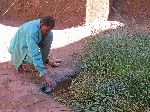|
Ethiopia: Abyssinia Adventure Lalibela Road Bicycle Africa / Ibike Tours |
|||
 |
Lalibela used to be a remote mountain side village. Due to its rock hewn churches it has been a tourist destination for decades, but prior to 2000 most of the tourist arrived by airplane, In the first decade of the millennium the road was improved from Woldiya to Lalibela so now most motor vehicles could make the journey, By 2017 the entire road should be paved -- it will still be remote! |
 |
|
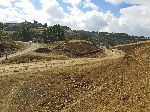 |
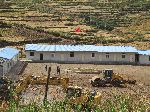 Our
route to Lalibela was via the gravel road that had only been built about a
decade earlier. But the Chinese flag was already
flying above the road construction camp and for short stretches work had begun grading and
preparing the base for the next generation asphalt road. Our
route to Lalibela was via the gravel road that had only been built about a
decade earlier. But the Chinese flag was already
flying above the road construction camp and for short stretches work had begun grading and
preparing the base for the next generation asphalt road.The gravel road was steeper in places than we had encountered on asphalt roads thus far in Ethiopia. On downhill sections, the bicycling was slow and treacherous. And on uphill sections, at times, we lost traction and had to push the bikes, which was slow. Even on the flat sections the scenery was so beautiful that we stop frequently to take photographs, so our forward progress was still slow. |
 |
|
 The net descent should have made this a relatively easy sections. What the profile doesn't show is that the first two-thirds of the route is gravel. It is mostly descent for 20 kms, then you climb and descend by the 30 km mark, and repeat again before 40 kms. Both the descents and ascent in this sections presented challenges. By the time we reached the paved section, the last third, it was mostly just a long slog up a mountain side. |
|||
 |
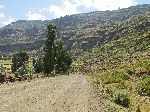
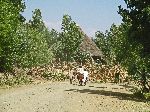
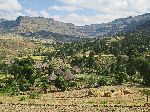
 |
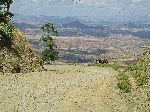 |
|
| Mostly the ride is about the views. Generally the area is sparsely inhabited. Besides the road and housing, some of the other signs of human life were terraced hillsides, a rural school, brightly painted churches on distant hills, irrigation ditch and a small group of people threshing their grains. | |||
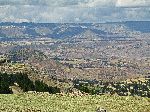 |
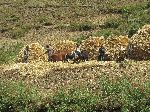
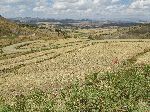
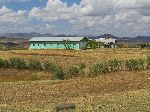
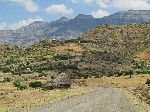
|
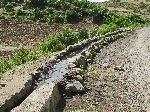 |
|
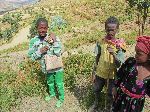 |
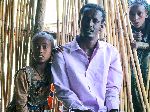
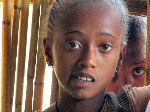


It might be that there is only on place to buy prepared food between Gashena and Lalibela. With
helpful directions from locals we found the restaurant -- it had no
sign. We ate
lunch, but not without some attention from the community. It was like
bicyclists didn't stop there everyday. |
 |
|
 |
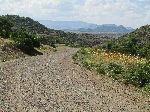

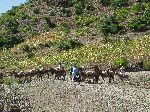
 After lunch, any optimism where it looked flat was short lived. The road was a gravel roller coaster until it crosses a tributary of the Tekeze River. These waters will eventually flow north around the Simien Mountains and reach the Nile River in Sudan, north of Khartoum. |
 |
|
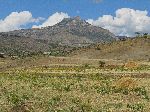 |
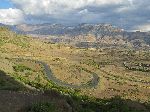
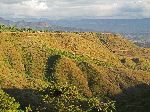

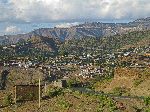
North of the river the road is paved. The net gain from the river to the
town is about 500m, but at the end of the day it seems at least twice that high.
You can be distracted from your exhaustion by the splendid views. |
 |
|
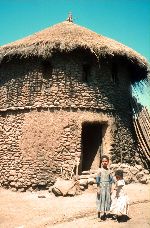 |

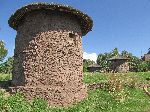
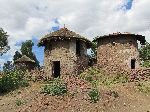
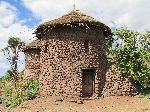 The traditional house of Lalibela was a round, red rock, two-story tukul. The highest concentration of these buildings is the Hadish Adi neighborhood, in the area around the sites of the rock-hewn churches. Starting in the 1980's a "church area" was identified and non-church related activities began to be restricted. In 1996, families were still living in the Hadish Adi tukuls (far left). Since then there was a trend by young people to choose more modern housing, but older people resisted relocation and wanted to stay in their tukul to be near their church. With the designation of the area as a World Heritage Site and the establishment of the "Ethiopia Sustainable Tourism Development Program" (ESTDP) the 96 remaining households were involuntarily relocated to new housing several kilometers away. They received larger plots of land and a building allowance, but because of limited mobility and devotion to their traditional church, this has angered a group of the people and severely degraded their overall quality of life. As part of the ESTDP, the local authorities plan is to preserve the vernacular houses.
Some of it is being repurposed into agency offices. |
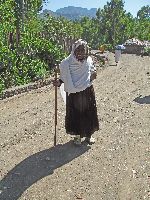 |
|
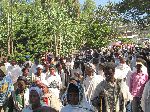 |
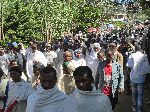 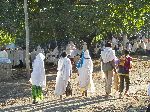
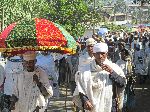
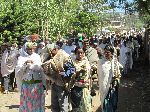 |
||
| Lalibela is considered the
second holiest city in Ethiopia (behind Axum) and has a very devote population.
On feast days people are out early and the paths and roads can be a stream of
white cotton shawls -- occasionally punctuated by a multicolor umbrella.
The perpetual attraction of Lalibela are eleven rock hewn churches grouped in two clusters and the stand alone St; George Church. Steeped in myth, these unique places of worship fully functions today in the Ethiopian Orthodox tradition as they have since workers (or angels) first tediously crafted the churches between 1180 and 1220 A.D, or perhaps earlier for some. The principle legend is that the churches of Roha sprung from the vision of King Lalibela. The local narrative is that the king traveled to Jerusalem during the 12th century and returned to create a "New Jerusalem" in Roha. While the churches do not resemble the architectural structures in Jerusalem, many were built in honor of biblical figures and others were dedicated to Ethiopian saints and prominent figures. Additionally, various landmarks around the area are named after sites in and around Israel. Another legend says that Lalibela was the brother of an incumbent king, and he was prophesied to become king himself after a swarm of bees covered him as a child. In a fit of jealously, his brother attempted to poison Lalibela, but instead cast him into deep, three-day sleep (of visions or hallusinations). That's when an angel led him to heaven (or Jerusalem), where he saw a city of rock-hewn churches. At the same time, his brother had a dream that Jesus Christ instructed him to give up the crown to Lalibela, which he did. As for excavating the churches, legends say it took divine intervention. Because of the massive size of some of the building, the depth of excavation, the sophistication of the engineering and the intricacy of the workmanship, this is totally believable. Scientists have calculated that it would have taken
a workforce of 40,000 man years to construct the churches. Locals claim that,
toiling all the hours of daylight, the earthly workforce was then replaced by a
celestial one, who toiled all the hours of darkness. In this way, the churches
rose at a miraculous speed -- in a matter of days. Regardless, they are
enormously impressive. |
|||
 |
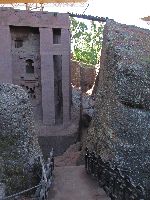
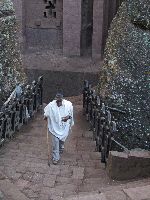
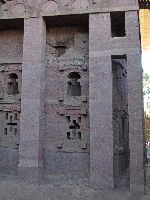
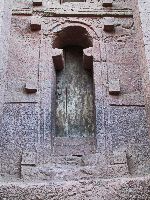 The first church of this account is Bet Medhane-Alem (House of the Redeemer of the World). It is the largest, monolithic, rock hewn church in the world. It has some elements of a Greek Temple. The engineering is mind boggling. The builders had to dig down on all four side, create tall, straight columns, allow for symmetrical, identical, indented window alcoves, chisel the windows and then precisely excavate the 36 pillars and eleven meter high chambers and naives inside. A theory put forward by various scholars is that Bet Medhane Alem is a copy in rock of the original Church of Our Lady of Zion at Axum, the principal shrine of Ethiopia which was destroyed in the sixteenth century by the Muslim leader Ahmed Gran, the Left-Handed. |
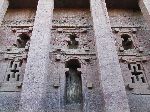 |
|
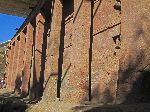 |
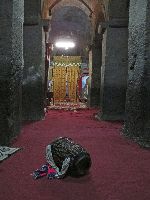
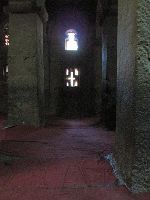
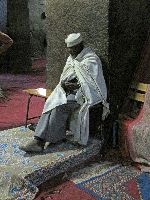
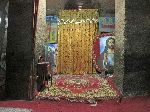
Bet Medhane-Alem has empty graves said to represent the biblical patriarchs Abraham,
Isaac, and Jacob. |
||
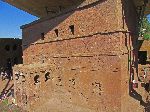
|
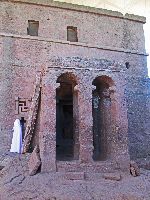
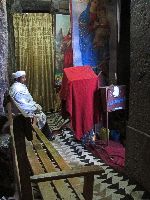
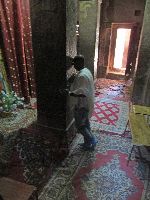
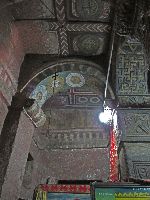
A second, smaller, monolith church, Bet Maryam, is in
the adjoining courtyard. It is dedicated to the Virgin Mary and by some accounts
is the oldest of Lalibela's churches. Bet Maryam is the most important and most beloved
church, not only by the Lalibela clergy but also of the
many pilgrims streaming into its courtyard on holy days. This popularity cannot
be ascribed exclusively to the legend that King Lalibela himself favored this
church above all having attended mass there daily. It has a simpler exterior,
but what it lacks on the outside it makes up for with its exquisitely decorated
interior. |
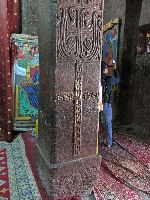
|
|
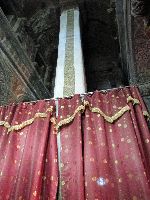 |
The shrouded pillars (left) reputedly inscribed with the Ten Commandments in Greek and Ge'ez, as well as the story of how the churches of Lalibela were excavated and created. The priests say that this pillar glowed brightly until the 16th century and they claim it would be too dangerous to lift the veil for others. In a variation, the priests explain that Christ touched the pillar when appearing to King Lalibela in one of his visions. Since that time the past and the future of the world are written on it. Since man is too weak to bear the truth revealed by God, the pillar is covered.
|
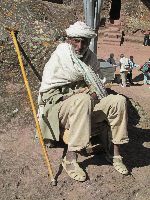 |
|
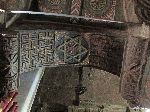 |
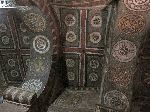
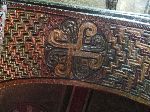
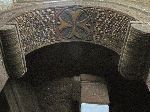
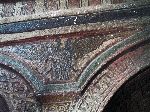 Elaborately and expertly carved into the ceiling are Stars of David, Moline Crosses, Crosses with looped arms, double headed eagles*, Lalibela crosses and a high density of geometric designs and motifs. * The double headed eagle has a long history in the Eastern Orthodox Church.
It was used during the Byzantine Empire (11th C.) to symbolized the unity
between the Byzantine Orthodox Church and State. It was used after that around
the northeastern Mediterranean. It shows up on coat of arms in eastern
Europe (Russian Orthodox) in the 19th century. Its use in Lalibela
probably dates to the 12th century or earlier. |
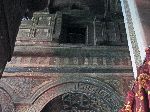 |
|
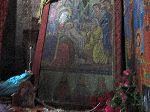

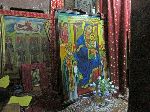
Bet Maryam also house a number of paintings and other treasure, some of which
are on public view. |
|||
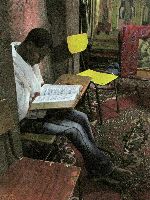 |
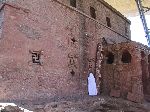 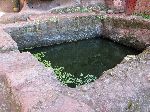 While
the United Nations has gazetted Lalibela as a World Heritage Site and
tourist, like ourselves, come and hardly pause longer than the time it takes to
compose a photo, all of the areas in and around the church still function
completely as their original intended purpose. In almost every church there will
be someone reading scripture, often a priest, there are several pools in the
complex that are used for rituals -- depending upon the pool and the source of
information believers are dipped either as a cure for infertility, if immersed
on the Orthodox Christmas or for baptism
-- and both inside and outside the churches people pause for lengthy periods of prayer. While
the United Nations has gazetted Lalibela as a World Heritage Site and
tourist, like ourselves, come and hardly pause longer than the time it takes to
compose a photo, all of the areas in and around the church still function
completely as their original intended purpose. In almost every church there will
be someone reading scripture, often a priest, there are several pools in the
complex that are used for rituals -- depending upon the pool and the source of
information believers are dipped either as a cure for infertility, if immersed
on the Orthodox Christmas or for baptism
-- and both inside and outside the churches people pause for lengthy periods of prayer. |
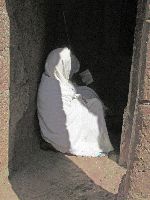 |
|
|
|
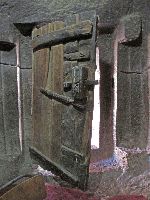
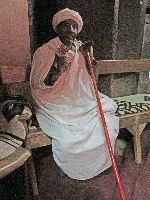 In the same courtyard as Bet Maryam is the much small Bet Meskel (House of the Cross), a rock-hewn cave church, carved into the wall of the depression. It contains a small chapel. |
||
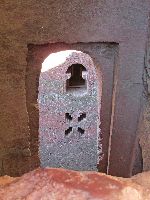 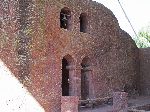 On
the opposite side of Bet Maryam is Bet Danaghel (House of the Virgin Martyrs).
According to a
legend recorded in the Ethiopian Book of Martyrs, the chapel was contracted in
honor of 50 Christian maiden nuns murdered on the orders of the
4th-century Roman emperor Julian in Edessa (modern-day Turkey). Many of its
features – the cruciform On
the opposite side of Bet Maryam is Bet Danaghel (House of the Virgin Martyrs).
According to a
legend recorded in the Ethiopian Book of Martyrs, the chapel was contracted in
honor of 50 Christian maiden nuns murdered on the orders of the
4th-century Roman emperor Julian in Edessa (modern-day Turkey). Many of its
features – the cruciform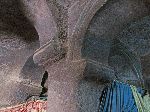 pillars and bracket capitals
– are typical architectural features of the churches pillars and bracket capitals
– are typical architectural features of the churches |
|||
|
|
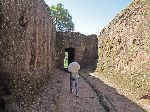 The passages between the courtyards are also carved in the rock and
within the complex there
are are a number of lengthy tunnels connecting courtyards and churches. The passages between the courtyards are also carved in the rock and
within the complex there
are are a number of lengthy tunnels connecting courtyards and churches. |
||
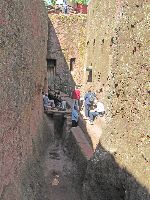 |
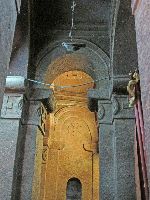
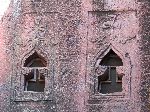
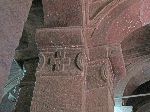
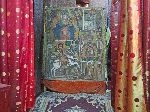 At the west end of the northwest cluster are the twin churches of Bet Mikael (a.k.a. Bet Debre Sina) and Bet Golgotha. They share an entrance through Bet Mikeal, but have different natures.
Bet Mikael (above) has high ceilings and some decorate carving. |
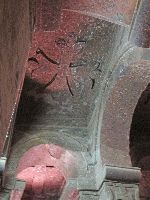 |
|
| Bet Golgotha (below) is more intimate and has the images of seven life-sized saints carved into its walls. It is the one church in Lalibela that women are not allowed to enter. It is said that King Lalibela is buried here. The Selassie Chapel, which lies within Bet Golgotha, is considered the holiest place in Lalibela. | |||
|
|
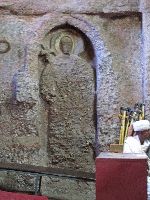

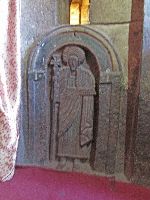
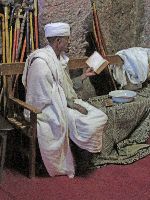
|
||
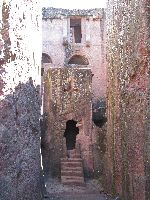 The hollowed out block of stone in the center of the image (left) is called the
Tomb of Adam. The opening is part of the passage from Bet Mikael out of the
complex. I am still searching for clarity on way it is called the Tomb of Adam. The hollowed out block of stone in the center of the image (left) is called the
Tomb of Adam. The opening is part of the passage from Bet Mikael out of the
complex. I am still searching for clarity on way it is called the Tomb of Adam.Following the passage will take you southwest to the iconic Church of St. George, Bet Giyorgis. It is rare that a set of images of Lalibela doesn't contain a picture of Bet Giyorgis. It is probably the most photographed church in Lalibela, Ethiopia, and on the continent of Africa. |
|||
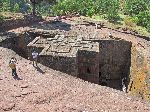
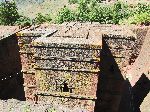

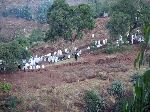 Approaching Bet Giyorgis, a monolith rock hewn church, you first see a Greek
cross chiseled into the hill top. As you draw nearer it becomes apparent
that it is the roof of a towering building. And as more of the building comes into
view you see the details of the church. It is often possible to identify
the location of Bet Giyorgis because petitioners stand at the edge of the chasm
to pray.
Approaching Bet Giyorgis, a monolith rock hewn church, you first see a Greek
cross chiseled into the hill top. As you draw nearer it becomes apparent
that it is the roof of a towering building. And as more of the building comes into
view you see the details of the church. It is often possible to identify
the location of Bet Giyorgis because petitioners stand at the edge of the chasm
to pray. |
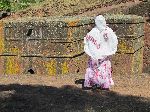 |
||
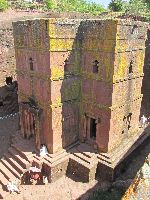 |
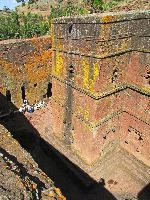

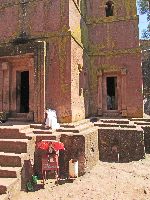
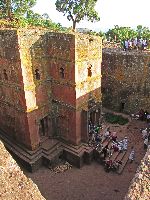 |
 |
|
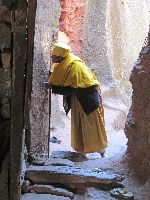 |
From every angle Bet Giyorgis is impressive. It also seems to be one of the most popular churches in Lalibela. This may be due to the presences it commands. The story goes that Girorgis was so offened that none of Lalibela's churches
was dedicated to him that he personally visited the King to set him straight.
Lalibela responded by promising he would build the finest of all his churches
for Giyorgis. So enthusiastic was the saint to see the results that he
rode his horse right over the wall into the entrance tunnel. The holes in
the stone tunnel walls are the hoof prints It is the custom for believers to kiss the wall as they enter the tunnel. In the enclosure there is a pond that is said to have wholly water. |
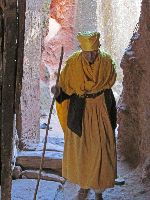 |
|
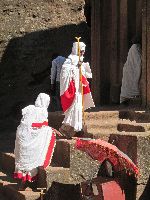 |
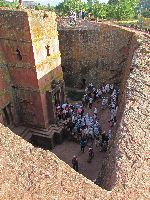
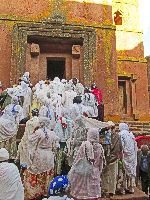
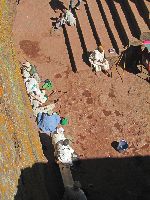
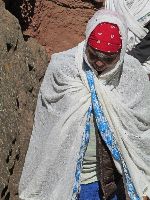 |
 |
|
|
|
|||
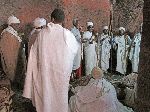 |
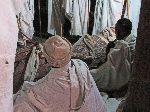 The
public chapel is in Bet Giyorgis is not big to begin with and it is often
crowded with the faithful so there is an anteroom carved into the wall of the
enclosure where the musician chant and
drum their praises. The ritual can last more than an hour. The
public chapel is in Bet Giyorgis is not big to begin with and it is often
crowded with the faithful so there is an anteroom carved into the wall of the
enclosure where the musician chant and
drum their praises. The ritual can last more than an hour. |
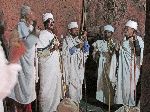 |
|
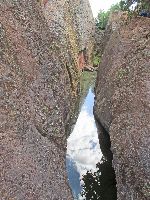 |
The second cluster of churches, to the southeast, is full of curiosities.
In an unusual consensus, many past scholars and local tradition agree that many churches date from around King Lalibela’s reign in the 12th or 13th century. But more recent scholarship date some of the structures to the 7th and 8th century. This puts them in the period of King Kaleb (Axumat). Which might help to explain some of the Axumite features of some of the buildings. |
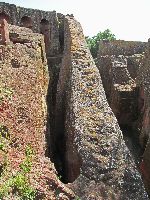 |
|
 |
 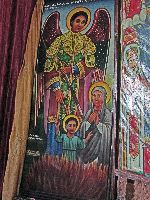  Bet Gabriel-Rafael is a tall, two story building with no entrance on the first
floor, and any rooms at that level are only rumored. The access to the
second floor is of modern construction. British archeologist David Phillipson concludes that both Bet Gabriel-Rafael is a tall, two story building with no entrance on the first
floor, and any rooms at that level are only rumored. The access to the
second floor is of modern construction. British archeologist David Phillipson concludes that both
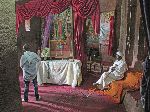 Bet Gabriel-Rafael and the nearby Bet Mercurios
were excavated as the core of a fortified palatial complex during the
politically unstable 7th and 8th centuries, when the Axumite Empire was in the
process of disintegrating. The orientation and floor plan of the interior
doesn't suggest that it ever was intended to be a church. It is small and plain,
the rooms are irregularly shaped and the floors are
much more uneven than most of those in the northwest complex. It has a few
relatively new looking painting. Bet Gabriel-Rafael and the nearby Bet Mercurios
were excavated as the core of a fortified palatial complex during the
politically unstable 7th and 8th centuries, when the Axumite Empire was in the
process of disintegrating. The orientation and floor plan of the interior
doesn't suggest that it ever was intended to be a church. It is small and plain,
the rooms are irregularly shaped and the floors are
much more uneven than most of those in the northwest complex. It has a few
relatively new looking painting. |
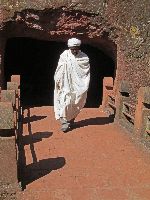 |
|
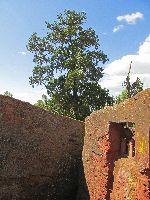 |
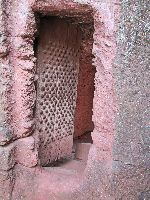
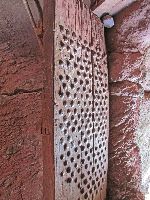
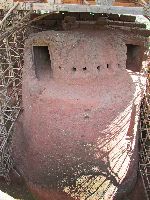
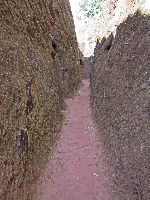 Bet Lehem can be reach by a passageway 50 meters long that starts at the right-hand aisle of Bet Emanuel, and passes Bet Metcurios and the courtyard of Abba Libanos. The shrine has been shaped into a cone by the central trench; the tunnel still winds up in spiral form within the hill and ends in a low, round room. A tree-trunk in the room serves as a central pillar. It has to be admitted that the original function of this shrine is not known. As a matter of fact, it has three names: "Hermit's Cell of King Lalibela''', "Bet Lehem, the Bakery of the Eucharistic Bread" and "Stable of King Lalibela's Horse". |
||
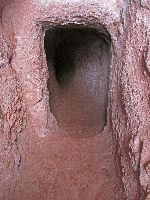 |
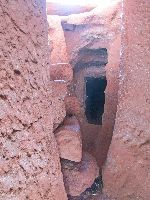
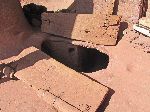
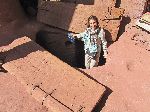 Tunnel near Bet Gabriel-Rafael (rock hewn church), Lalibela, Ethiopia |
||
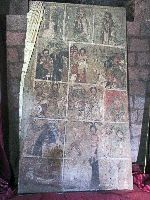 |
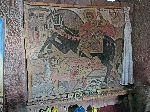 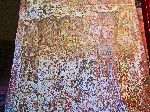 Bet Mercurios
is a cave church. It is believed to have originally been used for secular
purposes, and like Bet Gabriel-Rafael, may date back to the 7th century. The
church features a multi-frame painting of the Passions of Christ (left), a faded
frieze of three wise men in the company of other, or a group of saints (center-left) that is dated to the 15th century, a painting features St Mercurios slaying the King Oleonus (Emperor Julian the Apostate, 361 to 363, the last
non-Christian emperor of the Roman Empire. He has a complex legacy: He showed support to Jews
in Judea, and was
noted as a military commander, theosophist, social reformer, and man of letters. In Ethiopia he is associated with the martyring of Christians)
(center-right), and a painting of Ethiopian Saint Gebre Menfes Kidus (aka Saint
Abbo) with Lions and Leopards (right) (like St Francis, he is know as a friend
of animals). Bet Mercurios
is a cave church. It is believed to have originally been used for secular
purposes, and like Bet Gabriel-Rafael, may date back to the 7th century. The
church features a multi-frame painting of the Passions of Christ (left), a faded
frieze of three wise men in the company of other, or a group of saints (center-left) that is dated to the 15th century, a painting features St Mercurios slaying the King Oleonus (Emperor Julian the Apostate, 361 to 363, the last
non-Christian emperor of the Roman Empire. He has a complex legacy: He showed support to Jews
in Judea, and was
noted as a military commander, theosophist, social reformer, and man of letters. In Ethiopia he is associated with the martyring of Christians)
(center-right), and a painting of Ethiopian Saint Gebre Menfes Kidus (aka Saint
Abbo) with Lions and Leopards (right) (like St Francis, he is know as a friend
of animals). |
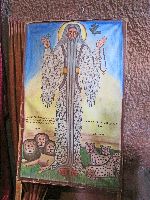 |
|
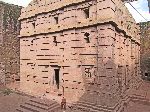 |
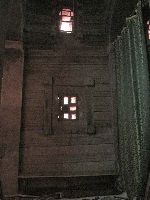
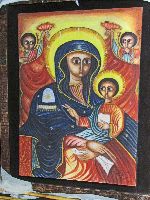
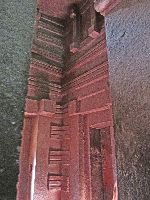
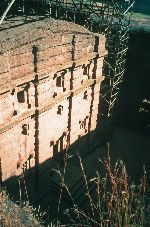 Bet Emanuel is a 12m-high, the only monolith the southeast complex and the most architecturally sophisticated church in Lalibela. One explanation is that was the private church of the royal family. |
||
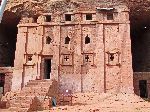 |
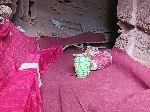
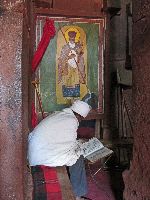
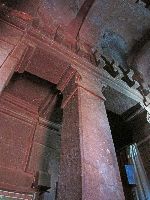
 Bet Abba Libanos is built into a cave. According to legend it was built overnight by Lalibela's wife Meskel Kebre, assisted by a group of angels. |
||
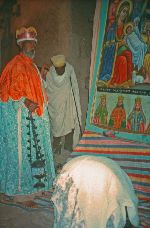 |
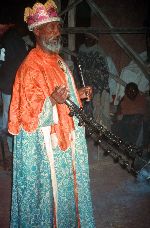
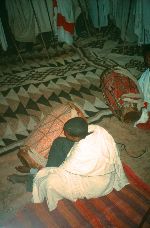
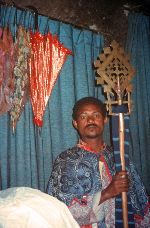
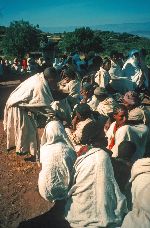
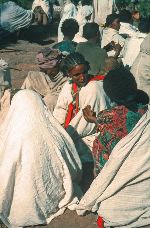
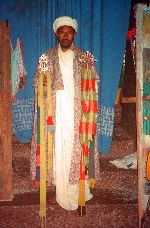
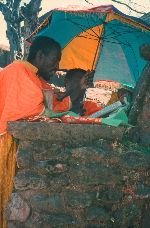
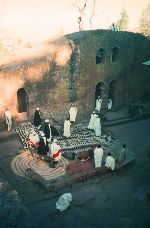
 |

|
|
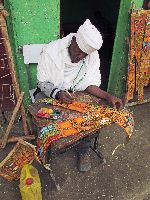 |

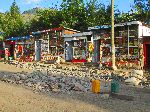 The
authorities of Lalibela has done a lot to reduce the hassle-factor of visiting
Lalibela pre-2000. On my most recent visit we were able to walk to site entrance
without being solicited about a guide, beggars and street kids, and there was no
aggressive commercialism. At the entrance official guide were available.
The street kids came out in the evening making leisurely walks a bit
problematic. The
authorities of Lalibela has done a lot to reduce the hassle-factor of visiting
Lalibela pre-2000. On my most recent visit we were able to walk to site entrance
without being solicited about a guide, beggars and street kids, and there was no
aggressive commercialism. At the entrance official guide were available.
The street kids came out in the evening making leisurely walks a bit
problematic.As you exit the church sites there are some artist stalls and on the main street there are some souvenir shops that you can visit at your leisure. |
 |
|
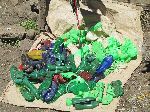 |
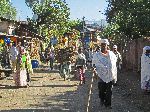 |
||
|
|
|||
|
|
Unique Programs To Special Places For Memories Of A Lifetime!
"Hosted by
DreamHost - earth friendly web hosting"
|
|
